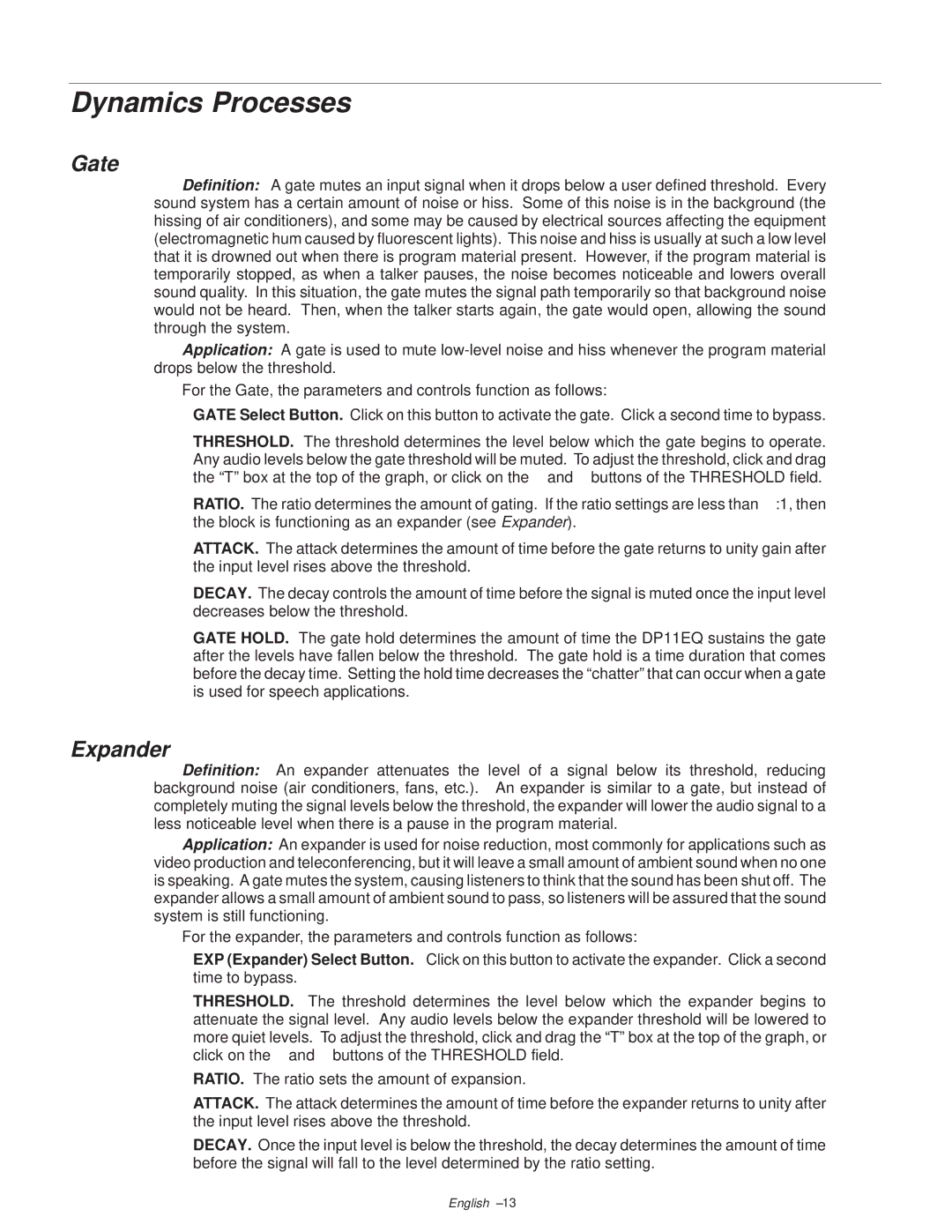Dynamics Processes
Gate
Definition: A gate mutes an input signal when it drops below a user defined threshold. Every sound system has a certain amount of noise or hiss. Some of this noise is in the background (the hissing of air conditioners), and some may be caused by electrical sources affecting the equipment (electromagnetic hum caused by fluorescent lights). This noise and hiss is usually at such a low level that it is drowned out when there is program material present. However, if the program material is temporarily stopped, as when a talker pauses, the noise becomes noticeable and lowers overall sound quality. In this situation, the gate mutes the signal path temporarily so that background noise would not be heard. Then, when the talker starts again, the gate would open, allowing the sound through the system.
Application: A gate is used to mute
For the Gate, the parameters and controls function as follows:
GATE Select Button. Click on this button to activate the gate. Click a second time to bypass.
THRESHOLD. The threshold determines the level below which the gate begins to operate. Any audio levels below the gate threshold will be muted. To adjust the threshold, click and drag the ªTº box at the top of the graph, or click on the↑ and ↓ buttons of the THRESHOLD field.
RATIO. The ratio determines the amount of gating. If the ratio settings are less than ∞ :1, then the block is functioning as an expander (see Expander).
ATTACK. The attack determines the amount of time before the gate returns to unity gain after the input level rises above the threshold.
DECAY. The decay controls the amount of time before the signal is muted once the input level decreases below the threshold.
GATE HOLD. The gate hold determines the amount of time the DP11EQ sustains the gate after the levels have fallen below the threshold. The gate hold is a time duration that comes before the decay time. Setting the hold time decreases the ªchatterº that can occur when a gate is used for speech applications.
Expander
Definition: An expander attenuates the level of a signal below its threshold, reducing background noise (air conditioners, fans, etc.). An expander is similar to a gate, but instead of completely muting the signal levels below the threshold, the expander will lower the audio signal to a less noticeable level when there is a pause in the program material.
Application: An expander is used for noise reduction, most commonly for applications such as video production and teleconferencing, but it will leave a small amount of ambient sound when no one is speaking. A gate mutes the system, causing listeners to think that the sound has been shut off. The expander allows a small amount of ambient sound to pass, so listeners will be assured that the sound system is still functioning.
For the expander, the parameters and controls function as follows:
EXP (Expander) Select Button. Click on this button to activate the expander. Click a second time to bypass.
THRESHOLD. The threshold determines the level below which the expander begins to attenuate the signal level. Any audio levels below the expander threshold will be lowered to more quiet levels. To adjust the threshold, click and drag the ªTº box at the top of the graph, or click on the ↑ and ↓ buttons of the THRESHOLD field.
RATIO. The ratio sets the amount of expansion.
ATTACK. The attack determines the amount of time before the expander returns to unity after the input level rises above the threshold.
DECAY. Once the input level is below the threshold, the decay determines the amount of time before the signal will fall to the level determined by the ratio setting.
English ±13
